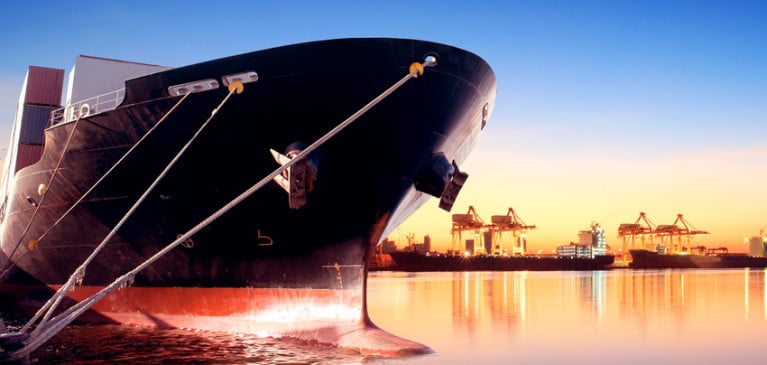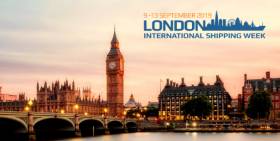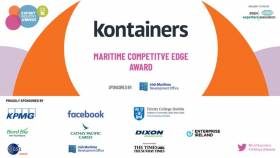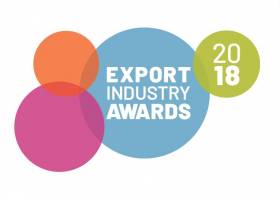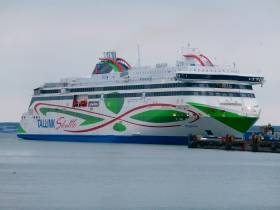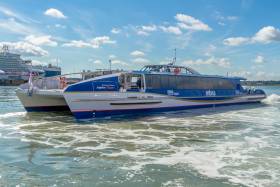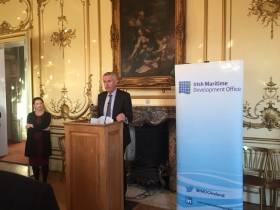Displaying items by tag: IMDO
As an island nation, Ireland is dependent on ports and shipping services to transport goods, and 90% of our trade is moved though Irish ports.
Shipping and maritime transport services make a significant contribution to Ireland’s ocean economy, with the sector generating €2.3 billion in turnover and employing over 5,000 people in 2018.
The importance of Ireland’s ports and shipping services is the focus of this week’s Oceans of Learning series, with resources from the Marine Institute and Irish Maritime Development Office (IMDO).
Ireland’s maritime industry continues to grow and progress each year with Irish ports and shipping companies making significant investments.
The ports sector in Ireland is currently undergoing a number of expansions and developments — with Dublin Port’s Alexandra Basin development, the development of Ringaskiddy in Cork by Port of Cork and the development of Shannon Foynes Port.
Along with these major investments, shipping companies are also investing heavily in new tonnage, with Irish Ferries, CLdN and Stena leading new build programmes.
IMDO director Liam Lacey said: “The Irish maritime industry can look to the future with confidence. It has shown itself to be resilient and agile in responding to challenges.
“Over the past decade, it has had to respond to the challenges of the financial crisis of 2008, the uncertainty surrounding Brexit and recent challenges. Ireland’s maritime sector has continued to underpin our economy by maintaining vital shipping links for both trade and tourism.”
Oceans of Learning offers downloadable resource such as fact sheets, a quiz and posters on Ireland's shipping sector. To access the resources for this week’s series, visit Port of the Future.
For more information on Oceans of Learning, visit www.marine.ie and follow the Marine Institute on Facebook, Instagram and Twitter.
IMDO Remains Open For Business With Staff Working Remotely
It’s business as usual at the Irish Maritime Development Office — albeit remotely for now to protect employees, clients and stakeholders amid the ongoing Covid-19 pandemic.
The IMDO says it is firmly committed to supporting the Department of Transport, Tourism and Sport, the Marine Institute and the maritime industry, including the ports and shipping companies, during this turbulent period.
For queries on how the IMDO can assist, get in touch via email [email protected] and you will be put in touch with the right person who can help.
Meanwhile, the IMDO urges everyone to please continue to take every precaution necessary to protect yourself, your family and loved ones, and anyone you interact with.
Irish Continue Presence on Banks of the Thames During London International Shipping Week
Following a recent re-enactment to retrace Granuaile, the Irish Pirate Queen's voyage from the west of Ireland to London where she met the Virgin Queen in 1593, the Irish will again be present in the UK capital as part of a major maritime event next week, writes Jehan Ashmore.
The event is the London International Shipping Week (9-13th Sept.) though only first held in 2017, LISW returns to the Thames and is regarded as one of the largest maritime events in the world. During the week, major announcements will be made by industry and government on the future of the UK’s £40bn maritime sector.
Aptly a present day Royal link is connected also with maritime matters as Princess Anne is to launch LISW19 along with senior British Cabinet ministers including Minister for Maritime, Nusrat Ghani MP, when they officially welcome 500 of the world’s leading maritime executives, diplomats and heads of government.
Among the packed-filled event programme of seminars, conferences and receptions is the LISW19 International Maritime Cluster Round Table Debate which is to be sponsored by the Irish Maritime Development Office. The IMDO is an Irish government office which provides support to national and international maritime businesses in Ireland in addition the agency works to provide independent advice and guidance on EU funding initiatives.
The LISW debate will involve maritime clusters represented from those in the UK, Singapore, Monaco, Hong Kong, US, Ireland, Norway, Greece, Cyprus and Malta. Leaders of these maritime clusters from around the world will discuss and debate key issues facing the way clusters operate independently. In addition the debate will provide an opportunity as to how they can improve cooperation between themselves.
Following the debate and discussion session will be lunch held on Wednesday (11th Sept.) at the offices of Norton Rose Fulbright, 3 More London Riverside. The morning invitation only held event has a target audience representing shipowners, managers, brokers, insurance related businesses, ports, regulators and financial services. For further information about LISW19, this can be found on the event's dedicated website here and event guide.
The venue of London Riverside as the name suggests is within sight of Tower Bridge, Pool of London where the re-encactment of Granuaile (Grace O'Malley) voyage (as alluded above) took place at the historic setting of the Pool of London. Afloat will have more from this tourist attraction during the course of the event week.
Completion of the re-enactment trip to the UK capital involved ocean-race boat, Believe in Grace which was solo sailed by Joan Mulloy from County Mayo, whose ancestor was Grace of Malley also known as the Pirate Queen of Mayo.
Kontainers - Winner 'Maritime Services Company of the Year' at Export Industry Awards
#Ports&Shipping - Kontainers, Dublin were the winner of the 'Maritime Services Company of the Year' at the annual Irish Exporters Association’s (IEA) Export Industry Awards.
The award sponsored by the Irish Maritime Development Office (IMDO), recognised the work of Kontainers, a digital partner in cutting edge ocean freight platforms, currently serving some of the biggest brands in shipping.
Portwest based in Westport, Co. Mayo, a manufacturer and distributor of work wear, safety footwear and peronal protection equipment, was the Overall winner of the Exporter of the Year Award 2018.
The prestigious award sponsored by the IEA, saw some 500 export industry professionals attend the gala awards ceremony last Friday at the Clayton Hotel, Burlington Road, Dublin. Also in attendence at the black tie event were diplomats representating over 25 embassies in addition to applicants and their guests.
The premier event now in its 18th year, has 12 categories that recognise the remarkable achievements of companies working in the export industry in Ireland.
#Ports&Shipping - The Irish Maritime Development Office (IMDO) the State agency responsible for the development, promotion and marketing of the shipping and services sector, have produced a report, "Implications of Brexit on the Use of the Landbridge".
Published online yesterday by the IMDO, the report uses quantitative and qualitative methods to determine the volume of Irish imports and exports that use the UK landbridge on an annual basis. In addition the report proposes seven Government recommendations to mitigate against any negative impacts of Brexit on Irish economic sectors and transport routes.
The report was carried out under terms of reference set by the Department of Transport,Tourism and Sport. The study quantifies the volume of Irish import and export traffic that uses Landbridge. It also establishes the drivers of the choice to use the landbridge
Assisting the report study were the Irish Exporters Association (IEA), the Irish Road Haulage Association (IRHA), the Freight Transport Association of Ireland (FTA Ireland), Dr.Stephen Hynes, economics lecturer at NUI Galway, and director of the Socio-Economic Marine Research Unit (SEMRU), Dr. Andreas Tsakiridis, research associate in marine economics at SEMRU.
To view and or download the Report, click here.
Entries Open for 'Maritime Competitive Edge Award' At Export Industry Awards 2018
#Ports&Shipping - Take the opportunity to enter the Export Industry Awards 'Maritime Competitive Edge Award' sponsored by the Irish Maritime Development Office.
The IMDO posted an update yesterday to highlight the award among 11 categories at the annual Export Industry Awards organised by the Irish Exporters Association (IEA). The awards recognise the remarkable achievements of companies working in the export industry. Companies can enter from 11 Categories and be in with a chance to be selected as the 2018 Exporter of the Year.
To meet the criteria for consideration for the IMDO sponsored 'Maritime Competitive Edge Award', the company must be able to demonstrate how their service has led to export success in the maritime shipping services sector.
There is no application fee, however voting looms as it closes this Sunday 16th September.
For further information on the Award's objective and criteria click here and with a link to enter online.
All winners will be announced at the Gala Dinner on Friday, 16th November, held at the Clayton Hotel, Burlington Road in Dublin.
Tickets are available by clicking here.
Traffic of Irish Ports Saw Strong Growth in 2017
#Ports&Shipping - The Irish Maritime Transport Economist, a report produced by the Irish Maritime Development Office (IMDO) on Ireland’s maritime freight industry, was launched recently in Dublin.
The report now in its 15th year, shows that in 2017, total port traffic increased by 6%, with growth driven predominantly by unitised trade, Roll-on/Roll-off (RoRo) and Lift-on/Lift-off (LoLo) traffic, both of which grew by 4% in 2017.
The report also highlights a 14% increase in the number of cruise vessel calls into ports across the island of ireland, with 324 calls recorded in 2017.Passenger numbers between the island of Ireland, Great Britain and continental Europe reached 4.29 million passengers in 2017.
Key figures
- 6% increase in total Irish port traffic recorded in 2017
- 4% increase in Irish RoRo traffic to 1,120,438 freight units
- 4% increase in Irish LoLo traffic to 731,451 TEUs*
- 6% increase in total Irish bulk traffic
- Overall, passenger ferry traffic slightly increased at less than 1% in 2017 to 4.29 million
- 14% increase in cruise vessel calls recorded to ports on the island of Ireland.
Freight traffic
There was a 6% increase in overall shipping activity in 2017, with positive growth across all four quarters. Growth was driven by the LoLo and RoRo sectors, with activity increasing in both sectors by 4%. Ro/Ro traffic is a reliable indicator of the trade between Ireland and the UK. The UK accounted for 26% of ROI’s EU exports (+2% compared to 2016), a total of €16 billion. For EU imports, the figure from the UK is higher at 39% (+3%), amounting to €17 billion in value terms.
Total Bulk volume for the ROI grew by 6% to 30.3 million tonnes in 2017. This is the second consecutive year of growth, exceeding the 29.8 million tonnes figure recorded for 2015. All twelve ROI ports recorded increases in traffic for 2017. The last time Total Bulk through ROI ports recorded year-on-year growth was from 2010 – 2012.
Passenger traffic
Passenger numbers between the island of Ireland, the UK and Continental Europe saw only marginal growth of less than 1% in 2017. A total of just over 4.29 million passengers travelled on the Central, Continental, Northern and Southern Corridors. Just over 18,000 additional passengers were recorded to have travelled on these routes in 2017. This follows two years of decline in this market in 2016 (-2%) and 2015 (-3%).
Ireland’s cruise industry, however, has recorded steady growth since 2011, with 2014 as the only year recording a decrease in calls. An average of 9% increase in traffic has been observed throughout this period. 2017 was the highest year for calls into ports on the island of Ireland, a 61% increase from 201 calls to eight ports in 2011, to 324 call into ten ports in 2017. Passenger numbers have increased by 93% from 214,623 in 2011 to 415,115 in 2017.
Moving Forward
The IMDO is undertaking a number of important studies in 2018. Concerns have been raised about the likely impacts of Brexit on landbridge traffic and the flexibility that exists within the maritime industry to deal with significant modal shifts.The IMDO has undertaken research to address these concerns. The second study being undertaken is to look into the capacity of Ireland’s ports network. The third study undertaken is to examine the current capacities, infrastructure, facilities and services that ports must offer the developing offshore renewable energy sector, to include wind, wave and tidal energy resources.
The Irish economy remains heavily dependent on seaborne transport, with more that 90% of our merchandise trade moving by sea. Our maritime industry has shown itself to be responsive to changing market conditions and capable of flexing capacity to meet demand. It is noteworthy that there are major redevelopment projects underway in our Tier 1 ports. Dublin Port is currently constructing approximately 3km of quay walls and deepening the harbour basin and channel to accommodate larger vessels. The Port of Cork is working towards the relocation of much of the port’s traffic to a purpose built facility in Ringaskiddy that will accommodate larger vessels and increase capacity to meet the growing demands of the region. Shannon Foynes Port Company (SFPC) has, through its Master Planning Exercise, identified opportunities to increase the port’s capacity, particularly in relation bulk cargo flows and recognises the potential that exists within the Shannon Estuary to service the needs of the agricultural and energy sectors amongst others, building on the potential that deep water and available development land can offer various industrial users. Together, Irish ports are preparing for the future and meeting the objectives set out in National Ports Policy (2013) by leading the development of port capacity to facilitate economic growth.
Speaking at the launch of the 15th edition of the Irish Maritime Transport Economist, Liam Lacey, Director, IMDO, said: “2017 has been a successful year for the Irish maritime industry and although 2018 will bring challenges related to Brexit and other geopolitical factors, the ability of the industry to respond to such challenges was not in doubt. Our ports, shipping companies and policy makers have shown themselves to be responsive and adaptable in a very competitive environment and that experience lends confidence to their ability to meet future challenges.”
A full copy of the report can be accessed here.
Irish to Make Further Maritime Contacts Through Connecting Europe Conference
#ports&shipping - Following the Irish Maritime Development Office (IMDO) attendance of last week's LISW17, the Irish government shipping agency will also be attending the Connecting Europe Conference taking place this week in the Estonian capital of Tallinn.
The IMDO will also be exhibiting at the two-day event held at the Nordea Concert Hall between 21-22 September.
The event is being organised by the European Commission, Directorate-General for Mobility and Transport (DG MOVE), in cooperation with the Estonian Presidency of the Council of the European Union and Ministry of Economic Affairs and Infrastructure of the Republic of Estonia.
At the Connecting Europe Facility Conference in Tallinn, a number of key Irish ports and enterprising marine companies in areas of ICT and digitalisation will exhibit together with Ireland’s Marine Development Team and the Irish Maritime Development Office to communicate Ireland’s marine opportunity.
Our delegation is keen to build connections for potential collaborations in future projects, especially in the in the area of research, and to discuss Ireland's strengths in areas such as Digital Ocean, Smart Ports and the development of Ireland's ICT cluster.
New London Commuter Catamarans Enter Thames Service
#ferry - Afloat last week featured Dublin Discovered Boat Tours, the capital's only dedicated operator on the Liffey, among it's London counterparts are MBNA Thames Clippers which introduced brand new craft but also commissioned to transport commuters, writes Jehan Ashmore.
The newbuild Jupiter Clippper with capacity for 172 passengers is the youngest member of MBNA Thames Clippers having entered service last month following debut of sister Mercury Clipper. They join a fleet providing rapid transport services through central London on various routes based between Putney in the west to Royal Woolwich Arsenal in the east.
Both craft represent (as Afloat reported last year) the largest fast commercial passenger ferries contracted from a UK shipyard in over 25 years and to serve in the nation's coastal waters. The pair made the 200 nautical mile delivery passage from Wight Shipyard Co Ltd on the Isle of Wight to the Trinity Buoy Wharf in east London.
Combined the passenger catamarans form a £6.3 million investment in London’s port and transport infrastructure to provide an additional 14% capacity and increased frequency cross the River Thames network. They are the most technically advanced and energy efficient fast ferries so far for MBNA Thames Clippers that now totals a fleet of 17 craft. The operator expects by the end of 2017 to have carried over four million commuters and tourists alike on Old Father Thames.
The build process took 10 months to complete Jupiter Clipper and Mercury Clipper and this led to the creation of over 75 new jobs across the Isle of Wight and London in the process. The 35m long catamarans are of the Hunt Class Mark 2, designed by Australian naval architects One2Three based in Sydney. They are built to ultra-high specifications among them incorperating a low-wash hull design likewsise of near sisters Clipper Neptune and Galaxy Clipper of the Hunt Class. These slightly smaller 150 passenger capacity craft having only entered service in 2015, make up the most modern and largest fleet on the Thames.
Also as part of river developments before the end of this year will be the completion of three piers added to the MBNA Thames Clipper commuter network. The locations are Plantation Wharf Pier, Westminster Pier and Battersea Power Station Pier.
MBNA Thames Clippers are committed to making the river as accessible to as many people as possible. Also their support of the Port of London Authority (PLA) Thames Vision of doubling the number of people travelling by river and its target of 20 million commuter and tourist trips every year.
As part of the last week's London International Shipping Week attended by the IMDO, a private charter of Thames Clipper was planned by LISW17 for delegates to take a special excursion of the PLA terminals. Among them in London's east docklands is located in Erith (Conway's berth for aggregates) and where during LISW17 Afloat had tracked down cargoship Arklow Resolve (see rare Dublin Cargoship Call to 'Docklands')
It was at this same berth in Erith, that Afloat had also followed Arklow Resolve make a previous call in late August, having finally departed Dublin Port notably where the 2,999grt cargoship had made a rare layover period of more than a month. This took place in the capital's old inner port that is referred as the 'Docklands' quarter, the Irish equivalent of London's Canary Wharf occupied by the financial services sector.
New Ambassador of Ireland to the UK Launches Networking Reception During London International Shipping Week
#ports&shipping - Mr. Adrian O'Neill the recently appointed Ambassador of Ireland to the UK hosted a joint reception with the Irish Maritime Development Office (IMDO) on Wednesday during London International Shipping Week, writes Jehan Ashmore.
The IMDO which is the Irish government's development, promotional and marketing agency for the shipping and shipping services sectors held the evening networking reception for clients of LISW at the Irish Embassy in Grosvenor Place.
Ambassador O'Neill welcomed international shipping firms and related sectors of the industry to the Embassy. Also attending the event was an Irish delegation from Government agencies and industry representatives.
The annual ‘must attend’ international event is worth £22bn alone to the UK Maritime sector. This year more than 160 industry functions and unique networking opportunities for leaders across all sectors of the industry were organised.
Those taking part from the industry were– regulators, charterers, ship owners, ship managers, bunker suppliers, lawyers, ship brokers, bankers, insurers, insurance brokers, commodity traders and brokers, ship suppliers, port operators, shipping service providers and many more.


























